Miami Marlins UPDATED top 10 prospects for 2019

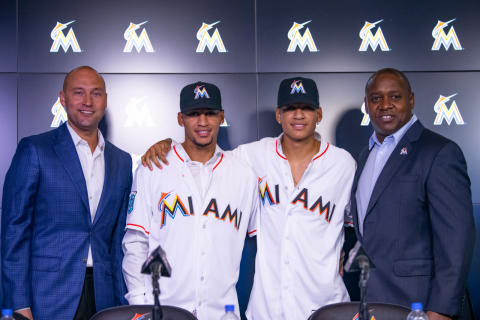
After finally dealing away their long-rumored catcher-on-the-move, the Miami Marlins have a new #1 prospect.
We are in our third offseason at Call to the Pen of putting together top 10 prospect lists for every organization in baseball. Today’s list is the Miami Marlins.
The Process
Our team prospect lists are compiled by Benjamin Chase, who has spent time doing plenty of watching via MiLB.tv of every organization in baseball along with talking to a very wide array of scouts who have seen players in person to hone his own opinion on players. That allows for a wide coverage on players from the Dominican Summer League all the way to the major leagues.
These lists are the opinion of Ben, and his process is heavily weighted on his own view, but also on trusted views of others. Typically, each system’s list of 10 is peeled down from a consideration list of 50-75 players. There will be some weight given to a player who is closer to the major leagues, but often these opinions will be different than some of the “major” lists out there. Feel free to comment at the end of the list with any questions you may have!
With that out of the way, let’s dig into today’s list:
Miami Marlins system review
Marlins list for 2017
Marlins list for 2018
Marlins 2018 minors all-stars
The Miami Marlins moved a significant portion of their young, exciting team in the 2017-2018 offseason, hoping to rebuild what was a horrible farm system. The moves have certainly helped to add depth to the system, though the team hasn’t acquired the elite player that they were hoping at least one player would become – at least not so far.
Poor luck has also doomed the Miami Marlins recently as first-round selections seemed to go down with Tommy John surgery each year after being drafted, a seeming curse. The Marlins have built up plenty of talent in their system, but these injuries have definitely taken a toll on the production from their farm system.
With new additions after the trade of their starting catcher, the Marlins now have one of those elusive elite prospects.
Let’s start with the countdown, starting with a player that fell outside of the top 10, but was picked up in 2018 via the draft or international signing and is worthy of extra attention going into 2019…
Osiris Johnson, SS
Birthday: 10/18/2000 (18)
Acquired: Draft, 2nd round, 2018
Level(s): GCL Marlins, low-A Greensboro
Statistics: .250/.276/.378, 48 G, 199 PA, 11 2B, 2 3B, 3 HR, 7 SB, 2.5% BB, 26.6% K
An incredible athlete, Osiris Johnson had a lot of intrigue coming into the 2018 draft. The Miami Marlins ended up signing Johnson after drafting him in the 2nd round for $1.35 million. Many scouts mentioned Twins prospect Royce Lewis in the way that Johnson improved his defensive skills over his final year of high school.
Still very raw, Johnson impressed in the GCL, hitting .301 in just 25 games, but he struggled when he was jumped up to low-A Greensboro. That’s not incredibly surprising for one of the youngest members of the draft class.
There’s a very real chance that his long-term position will be somewhere other than shortstop, but it won’t be due to a lack of range or a lack of arm, as he flashed both in his pro debut plenty. More than anything, the 19 errors he made in 46 games in the field were in part due to the game speeding up significantly for him and making judgment mistakes about when to throw the ball or not.
With at least plus speed, if not plus-plus, and raw power that is at least above-average. His rare combination of tools could allow him to be one of those elite prospects that the Marlins currently crave if he can develop his pitch and zone recognition at the plate in 2019.
10. Braxton Garrett, LHP
Birthday: 8/5/1997 (21)
Acquired: Draft, 1st round, 2016
Level(s): Did not pitch
Statistics: No stats
A gentle uptick in velocity by a notch or two made Braxton Garrett a hot property in the 2016 draft, climbing from a likely mid- to late-first-round pick to the 7th overall selection by the Miami Marlins.
Garrett pre-draft sat low- to mid-90s with his fastball, seeing his fastball tick up to touching 97. His best pitch was his tight-spin, high-rotation curveball. He used the pair to lead Team USA to a gold medal in fall of his senior year of high school.
The Miami Marlins gave him little use after drafting due to a heavy high school workload, making his first pitches in fall instructs, but just after he got on the field in 2017, he had to go under the knife for Tommy John surgery, costing him all of 2018.
With a mid-90s fastball and an elite curveball from the left side, Garrett at the least has the ceiling of a mid-rotation starter, but after losing essentially two full years of development, he will be behind the 8-ball, needing to move quickly and pick up his change quickly as well, something he didn’t throw a lot as a pro in his debut.

9. Connor Scott, OF
Birthday: 10/8/1999 (19)
Acquired: Draft, 1st, 2018
Level(s): GCL Marlins, low-A Greensboro
Statistics: .218/.309/.296, 50 G, 208 PA, 3 2B, 4 3B, 1 HR, 9 SB, 11.5% BB, 26.9% K
Another instance of the Miami Marlins grabbing a late-riser with the first pick they had in a draft, the Marlins selected Florida high school outfielder Connor Scott with the 13th pick this past June. Scott had jumped up draft boards with an impressive spring performance.
Scott is built long and lean, standing 6’4″ and weighing in at 180 pounds. He’s not likely going to add a lot of weight to his frame outside of transforming his frame to muscle more, though he could calm his impressive raw tools with too much forced bulk to his frame.
Like Astros outfielder Kyle Tucker, Scott has long strides and long limbs that he can use to track down balls in the outfield and generate impressive whip on his bat through the zone. While those long strides give Scott plus speed in motion, it also means it takes him a few strides to get to that point, which will mean he likely takes some time to iron out his base stealing instincts as his raw speed won’t be able to get him steals the way it did in high school.
While tracking late risers has bitten the Marlins in the past, they seem to have found a gem with Scott, most likely due to leaving the late-rising pitcher mold and instead pursuing a late-rising position player.
With a good idea of the strike zone already, Scott could advance quickly up the minor league system for the Miami Marlins, very feasibly staying in center field with a blend of power and speed.
8. Jorge Guzman, RHP
Birthday: 1/28/1996 (23)
Acquired: Trade with the New York Yankees, December 2017
Level(s): high-A Jupiter
Statistics: 0-9, 21 GS, 96 IP, 4.03 ERA, 1.54 WHIP, 14.9% BB, 23.5% K
Now on his third organization, Jorge Guzman was a late signee by the Houston Astros in June of 2014, already 18 when he was signed. He did not make his pro debut until the next season, when he jumped up both of the Astros Dominican Summer League teams to the GCL team.
He made huge strides in his second season of pro ball, significantly lowering his walk rate and showing an impressive 32.1% strikeout rate. He was traded after that season to the New York Yankees as part of the Brian McCann deal. The Yankees sent Guzman to the New York-Penn League in 2017, and he had an impressive season.
That 2017 season led to Guzman being a key piece of the Giancarlo Stanton trade between the Miami Marlins and Yankees last offseason. In his first experience in full-season ball, Guzman struggled with controlling his impressive stuff.
Guzman has touched 103 with his fastball and frequently sits in the upper-90s with his fastball. His slider has flashes of plus quality, coming in around 90 MPH with hard break, frequently breaking the bat of a lefty hitter and leaving righty hitters swinging hopelessly.
There’s really no two ways around Guzman needing to develop his delivery better to have a more consistent landing spot and a consistent arm action within his delivery, as he often would have a consistent landing spot, but he had arm drag through his delivery, needing to rush his arm, and leading to difficulty controlling his stuff.
The Miami Marlins will need to decide Guzman’s path soon as he’s going to be 23 heading into 2019 and has never pitched 100 innings. He could possibly be a dominant closer or develop as a mid-rotation starter, but he’ll need to work on his command and control to work in either role.

7. Zac Gallen, RHP
Birthday: 8/3/1995 (23)
Acquired: Trade with St. Louis Cardinals, December 2017
Level(s): AAA New Orleans
Statistics: 8-9, 25 GS, 133 1/3 IP, 3.65 ERA, 1.47 WHIP, 8.2% BB, 23.1% K
Taking one look at Zac Gallen‘s WHIP only from his season in the Pacific Coast League in 2018 would give you a skewed vision of what Gallen could really be for the Marlins, and that’s potentially one of the first positive returns on prospects gained in their tear-down deals of 2017-2018.
Originally a 3rd round selection by the St. Louis Cardinals out of the University of North Carolina, Gallen has moved quickly through the minor leagues, spending all of 2018 in AAA in just his second full minor league season.
Gallen did get hit in the air plenty in AAA in 2018, and he’ll need to utilize his two-seamer more to help with that going forward. Luckily, the pitch has seen its effectiveness tick up as Gallen’s velocity has ticked up as a pro, typically sitting in the 91-94 range and touching 95-96. He has excellent command of his fastball and change, and while he controls his curve well presently, his command of the pitch is still in progress.
There’s likely not a guy who will turn into a top of the rotation starter here, but thus far, Gallen’s simply eaten up quality innings at every level he’s been at. The Miami Marlins should give him a long look in the spring as a potential rotation member, and certainly, he should be an early call-up if the team finds itself with injury or ineffectiveness in the MLB rotation.
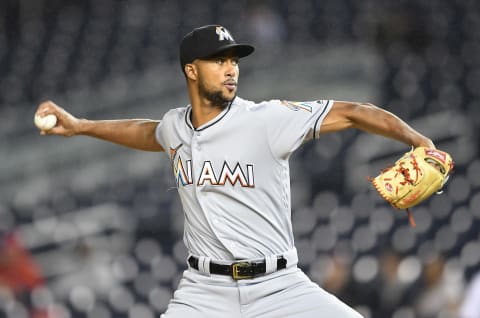
6. Sandy Alcantara, RHP
Birthday: 9/7/1995 (23)
Acquired: Trade with Cardinals, December 2017
Level(s): high-A Jupiter, AAA New Orleans, MLB Miami Marlins
Statistics: Minors: 6-3, 22 GS, 127 IP, 3.90 ERA, 1.26 WHIP, 8.1% BB, 18% K; Majors: 2-3, 6 GS, 34 IP, 3.44 ERA, 1.41 WHIP, 15.8% BB, 20.5% K
The St. Louis Cardinals signed Sandy Alcantara for $125K in 2013 out of the Dominican Republic. At 6’4″, Alcantara’s big fastball and frame made him an attractive signee. He immediately showed that big fastball, and in 2016 at age 20, he had a breakout year across both A-ball levels in the Cardinals organization, striking out 153 in 122 2/3 innings. That got him ranked #40 overall by Baseball Prospectus in their offseason top 100 list.
After an up-and-down 2017 season, Alcantara was traded by St. Louis to the Miami Marlins as the headliner of the return for outfielder Marcell Ozuna. He was coming off of a season where he finished in the Cardinals bullpen, impressing with an average 99 MPH fastball.
The Miami system allowed Alcantara to focus on his favorite pitch, and it paid off in the lower levels, as he was able to pound the lower part of the zone with his incredible upper-90s sinker and tended to lean heavily on his slider as a primary secondary pitch along with the sinker.
Alcantara made 6 major league starts for the Marlins after he was called up, and the focus was on developing his changeup, which has the potential to work with the sinker as an above-average offering. While Alcantara tended to use his hard curve as his third pitch in the minor leagues, he seldom used the curve in the majors.
The 2019 season should open with Alcantara in Miami, whether he’s firing hard sinkers in the rotation or unleashing his 102-MPH four-seamer in the bullpen.
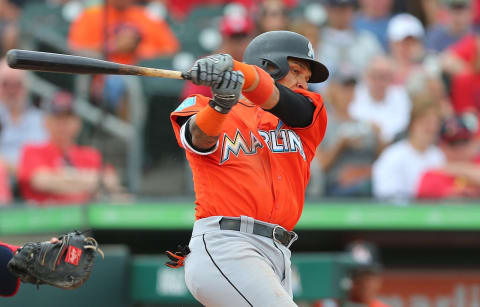
5. Isan Diaz, IF
Birthday: 5/27/1996 (22)
Acquired: Trade with Milwaukee, January 2018
Level(s): AA Jacksonville, AAA New Orleans
Statistics: .232/.340/.399, 119 G, 511 PA, 23 2B, 5 3B, 13 HR, 14 SB, 13.3% BB, 27.4% K
Typically, a player on his third organization since being drafted would be a guy who was a fringe prospect with fringe tools, but that’s the farthest from the case for Isan Diaz, who has now been at the center of two significant trades in his short time as a professional.
Diaz was originally drafted out of high school in Massachusetts as a raw player from a cold-weather state by the Arizona Diamondbacks. After a big season in the Pioneer League, Diaz had a lot of underground swell about his prospect ranking before he was included in the trade that sent Jean Segura to the Diamondbacks from Milwaukee.
In his first season in the Brewers system, Diaz hit 20 home runs in low-A as a middle infielder and was a consensus top 100 prospect across the board, ranking highest by Baseball Prospectus at #59. Though he struggled in 2017, he still flashed that power/speed combination and was an attractive prospect.
The Brewers used that to their advantage in acquiring Christian Yelich last offseason as Diaz was a key piece of the deal. Diaz struggled with injury early on and at the end of the season, but in June and July, Diaz hit .289/.403/.503 with 6 home runs and 8 steals over 51 games in those two months.
After reaching AAA in 2018, Diaz will likely open there in 2019, and he has the power and speed combo along with excellent defense at second base that could push him up to the major leagues, especially if the Miami Marlins move Starlin Castro.
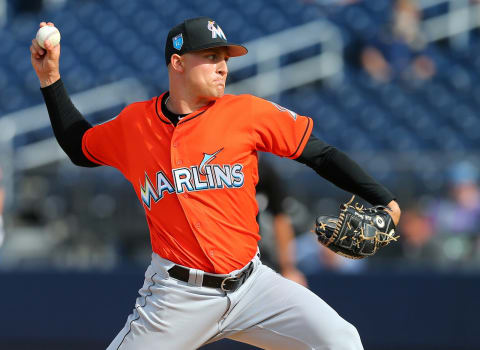
4. Nick Neidert, RHP
Birthday: 11/20/1996 (22)
Acquired: Trade with Seattle Mariners, December 2017
Level(s): AA Jacksonville
Statistics: 12-7, 26 GS, 152 2/3 IP, 3.24 ERA, 1.13 WHIP, 5.1% BB, 25.2% K
Typically a high school arm from the Atlanta metro area is going to be highly regarded and tracked, but even though Nick Neidert was a 2nd round pick in 2015 by the Mariners, he’s flown under prospect radars.
This has not been due to poor performance by any means. In his draft season, Neidert posted a 1.53 ERA and 0.96 WHIP over 35 1/3 innings in rookie ball. He opened the 2016 season in extended spring, but jumped straight to low-A once he began the year, posting a 2.57 ERA and 0.97 WHIP over 91 innings.
In 2017, Neidert showed very well at high-A, handling the difficult Cal League. He struggled with an end-of-season promotion to AA, but even with that, he posted a 3.45 ERA and 1.18 WHIP over the season with an impressive 22/122 BB/K over 127 2/3 innings.
Neidert was a key part of the first deal of the Miami Marlins tear down over the winter last offseason, as he was part of the return for Dee Gordon. He had an impressive year in his first year with the Marlins.
The pitch mix Neidert offers won’t blow anyone away, using a fastball that sits upper-80s and touches 93, but he has excellent movement and control of the pitch. Neidert mixes in a plus to double-plus change along with an above-average curve that has taken a big step forward over the last year. His ceiling isn’t tremendously high, but Neidert’s as close to a lock to be a major league starter as a minor league pitcher can be at this point, barring injury that is always a risk for a pitcher.
Neidert should get a chance to open 2019 in the rotation, but, failing that, he’ll open the year in AAA.
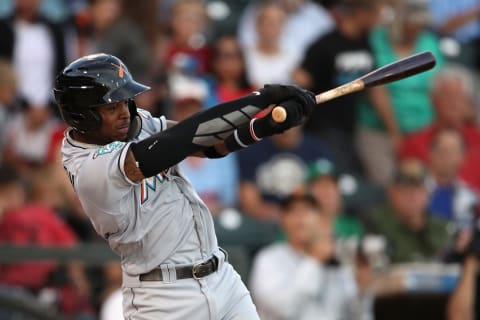
3. Monte Harrison, OF
Birthday: 8/10/1995 (23)
Acquired: Trade with Brewers, January 2018
Level(s): AA Jacksonville
Statistics: .240/.316/.399, 136 G, 583 PA, 20 2B, 3 3B, 19 HR, 28 SB, 7.5% BB, 36.9% K
There are few players in baseball who get off the team bus looking more impressive than Monte Harrison, and if his work in the Arizona Fall League this year is any indication, he may finally be ready to turn that elite physicality into production and polish on the field.
Originally drafted by the Brewers in the 2nd round out of high school in Missouri high school, Harrison has flashed his incredible athleticism with big speed and power in batting practice until 2017. In 2017, he had a breakthrough year, pounding 28 doubles and 21 home runs while stealing 27 bases.
Always one to strike out at a fairly heavy rate, the Miami Marlins were nowhere near prepared to see Harrison whiff the way he did in 2018. He did not let other pieces of his game suffer, still displaying power and speed.
He also displayed the thing that has become his trademark, his defense. Harrison is very feasibly the best defensive outfielder in the entire minor leagues, with the ability to be a Gold Glove defender in center field, but also arguably the best outfield arm in the minors that would allow him to be an elite corner outfielder.
Showing up to the Arizona Fall League, Harrison had made a few adjustments to his setup at the plate, and it’s made a world of difference. Against some of the top arms in the minor leagues and certainly some elite velocity, he has posted a .290/.383/.348 line, but most importantly, he’s posted a 12.3% walk rate and an impressive 23.5% strikeout rate for his previous work.
Harrison should open 2019 in AAA, and if his new approach can hold, he could be a threat at the top of the lineup for the Miami Marlins.
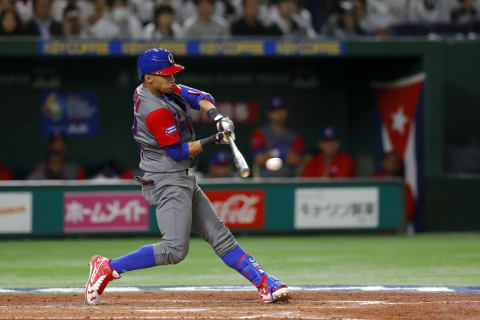
1. Victor Mesa, OF
Birthday: 7/20/1996 (22)
Acquired: International free agent, October 2017
Level(s): None
Statistics: None
Considered the top Cuban prospect available, Victor Mesa, aka Victor Victor, was signed by the Miami Marlins in October along with his brother.
Mesa is an elite defender in center field that will be his carrying tool immediately as he comes to the Marlins system. He has excellent instincts in center field and has a plus arm to pair with those instincts.
At the plate, Mesa has flashed power at times, but his swing doesn’t exactly portend consistent over-the-fence power, more likely leading to plenty of doubles and triples with his plus to plus-plus speed.
How Mesa’s eye translates to the states will determine how fast he moves to the major leagues. He has shown good contact ability in Cuba and in international competition, and if he could show similar ability with the bat along with his speed on the bases, he would plug in well at the top of the lineup for the Marlins.
Most likely, barring a tremendous spring training, Mesa will open in AAA in 2019, but he could be playing in Miami by the end of the season.
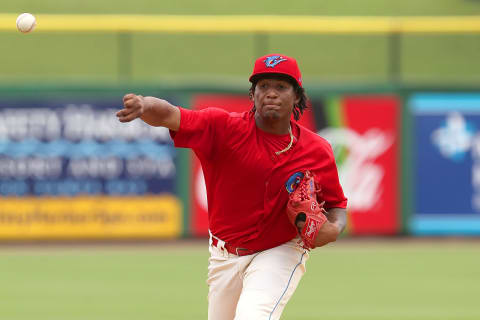
1. Sixto Sanchez, RHP
Birthday: 7/20/1996 (22)
Acquired: International free agent, March 2015
Level(s): high-A Clearwater
Statistics: 4-3, 8 GS, 46 2/3 IP, 2.51 ERA, 1.07 WHIP, 5.9% BB, 23.9% K
Do you like guys who throw triple digits? How about guys with two potential plus-grade secondary pitches? How about guys who can throw over 100 and still control the ball? Then you just may enjoy watching Sixto Sanchez.
More from Call to the Pen
- Philadelphia Phillies, ready for a stretch run, bomb St. Louis Cardinals
- Philadelphia Phillies: The 4 players on the franchise’s Mount Rushmore
- Boston Red Sox fans should be upset over Mookie Betts’ comment
- Analyzing the Boston Red Sox trade for Dave Henderson and Spike Owen
- 2023 MLB postseason likely to have a strange look without Yankees, Red Sox, Cardinals
One of my personal favorites since the first reports I got about him in 2015 from a scout in the Dominican, Sixto has an incredible repertoire currently with a fastball that can exceed triple digits, a plus hard curve, and a change that flashes a lot of plus in his starts. His fourth pitch is a slider that’s more average to above-average, but it gives a different look.
However, he is listed at 6′ tall, which could be an inch or two tall for reality, and he’s listed at 185 pounds, which is fairly developed on what is a more narrow frame, leaving him a worry for many scouts due to injury risk.
Sanchez has ended up with multiple injuries in his career to this point, but many of those games missed very well could be the team being cautious with Sixto due to the special level of his arm. No matter how you slice it, Sixto has elite raw stuff, arguably the best in the entire game.
Unlike many guys who can touch big velocity, Sanchez ends up pounding the zone with all of his pitches. That’s a big difference, and for Sanchez to reach his potential peak it could mean that he needs something with horizontal wiggle in the zone, perhaps something like a cutter to pair with his slider.
Sanchez’s floor is as high as can be as a potential power reliever that pounds the zone, but if he can put it all together, he could be a true ace. He’ll likely open in high-A in 2019 at 20, and should move quickly to AA if he can stay healthy.
Next. 2018 Minors All-Star team. dark
The signing of the Mesa brothers is a big coup for the Miami Marlins as is picking up Sixto, but they will need to see more production from their farm system to return to competitiveness in the near future.